2018 Activity Report
March Activity Report
31 March 2019
Global Japan Office Coordinator
Taguchi Kazumi
The March London Report will be featuring 3 different events.
The first event was a Koto concert staged at a SOAS lecture theatre. Dr. David Hughes, who planned and organised this event, invited a Koto Master, Yonekawa Toshiko II who, according to Dr. Hughes’ notes, “comes from a family lineage of koto and shamisen masters (her mother, Yonekawa Toshiko I, was a Living National Treasure)”, to give a performance.
Yonekawa Toshiko II played solo, then accompanied by her pupil, Mari Kamegawa who played Shamisen & sang. After that Yonekawa Toshiko II played with the Shakuhachi player, Clive Bell, then played Koto and sang. She ended her performance by playing with the viola player, Wenhan Jiang. This piece featured one of Yonekawa Toshiko II’s own compositions, incorporating different techniques into the performance which created new possibilities for the Koto. It was a great opportunity to see Koto playing which while maintaining the tradition also introduced us to contemporary innovations; it was an utterly fantastic performance.
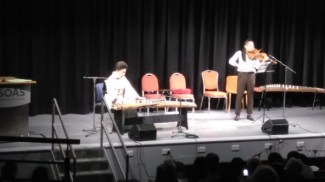
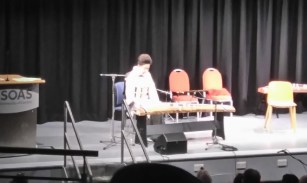
The next report is about Ura Matsuri which was part of the 2019 Season of Japanese Culture endorsed by the Japanese Embassy in the UK. The event was planned and organised by the Ura Matsuri Committee which was set up by members of the Frank Chickens, a local performance group consisting mainly of Japanese people living in the UK.
The audience was a heartening mix of different generations and types of people. The main aim of the event was to attract local people to come and celebrate and get a taste of Japanese popular culture, pop culture, ethnic music, Japanese culture as a part of East Asian culture, English culture influenced by Japanese culture, and local overseas Japanese culture. The Ura Matsuri committee carefully chose a selection of inspiring acts.
Ura Matsuri, an annual event, is now in its third year. The event took place at the Bethnal Green Working Men’s Club which has a capacity of around 300 people. The venue was full to the brim for the opening of this exciting cultural event. Ms. Toshiko Kurata, an Origami artist and member of Frank Chickens was compere for the night; and dressed up as an edgy granny for the occasion!
The event started with Akari Mochizuki performing Enka, that was followed by Hibiki Ichikawa playing Tsugaru Shamisen with his students, then there was a Butoh performance with improvising musicians by Mai Nguyen Tri. Next came a short film by Aya, after that, Beibei Wang performed powerful Chinese percussion with her students. The event ended with the Frank Chickens singing and dancing in their own inimitable style.
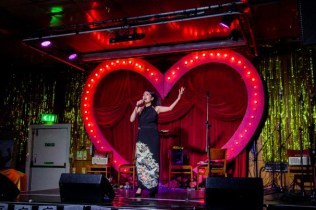
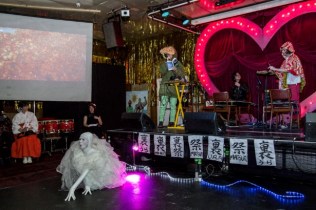
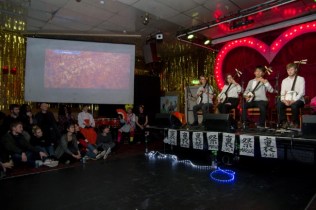
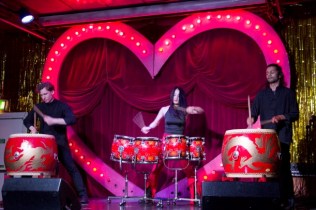
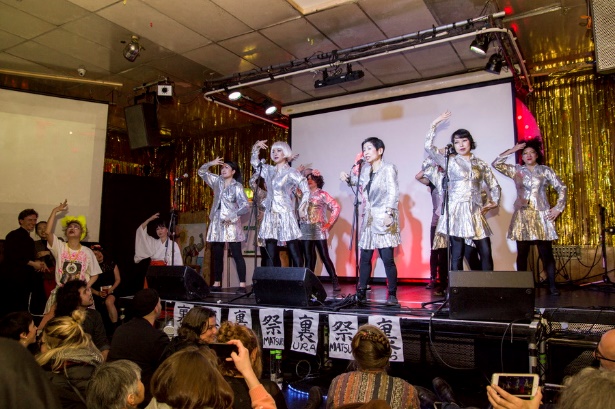
photos courtesy of David X Green; davidxgreen.com
As spring has now come to London, the third event is all about Hanami.
You can see cherry trees in many places in the UK and British people are passionate about gardening and horticulture as shown in events like The Chelsea Flower Show. Strangely enough, however, despite their passion for nature, there is no custom of going out to celebrate the Cherry blossom.
So, some Japanese women decided to get together and plan an excursion to admire the cherry blossoms in one of London’s Royal parks: Regent Park. The participants were all career women; a retired entrepreneur; a lecturer in Music at University; an improvisational singer; a beauty and fashion industry coordinator; and a theatre business coordinator. All of us brought amazing homemade Japanese food along to a celebration which consisted in spending an enjoyable and luxurious time sitting under a lovely cherry tree. It made us realise how important it is to take some time out and appreciate nature while eating homemade food, enjoying each other’s company and discussing interesting topics. It is both relaxing and re-invigorating. Hanami is definitely a great tradition.
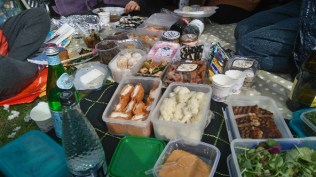
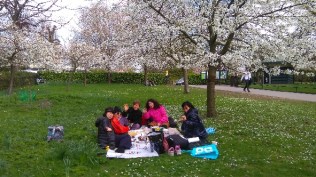
I would like to end the March report with a picture of a cherry blossom display made in a very British style. It is a picture of an Indian elephant made entirely of cherry blossom petals, which I saw at a shopping centre situated close to SOAS. This flower elephant was made to promote an Indian cultural event taking place at the centre over the weekend. The plaque at the side of the elephant says, “Please name me!”
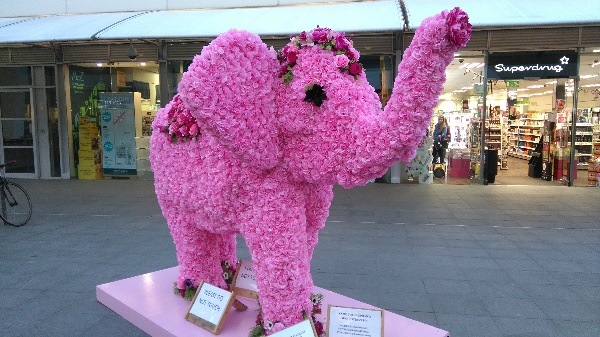
February Activity Report
28 February 2019
Global Japan Office Coordinator
Taguchi Kazumi
The February London report will deal with three topics. With the issue of Brexit hanging over them the British people were devastated by the news that Honda UK Manufacturing Company would be leaving the UK. Meanwhile Japanese culture is still going strong and continuing to make its presence felt in many different areas.
My first report concerns a music event which was held at the Brunei Lecture theatre, SOAS, and organised by the Department of Music. The event was a fundraising concert to collect money to buy musical instruments for the Music Department. The lecture theatre was absolutely full and there were seven different performances presenting music from different regions. It was an extremely fruitful evening which fitted a large number of performances into a tight two-hour schedule.
The event started with a group of three musicians and a singer presenting a fusion of Central Asian and Irish folk music. It was followed by a performance featuring an Indian string instrument and tabla. The third act was a singing performance accompanied by a special Southeast Asian string instrument. Then, there was a jazz fusion of Middle eastern and African Kora with singing. The fifth performance was Japanese folk music (Mainland and Okinawan) led by Dr. David Hughes. After that, there was music, singing and dancing from the Silk road. The last but by no means the least enjoyable group presented African Kora music and featured five Kora players. It was a luxurious two hours presenting high quality performances from different parts of the world. It was a truly multi-cultural event and one which is characteristic of SOAS.
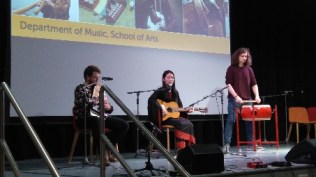
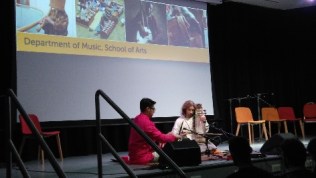
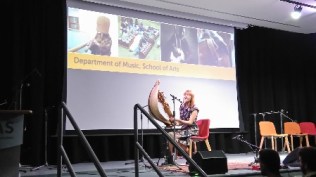
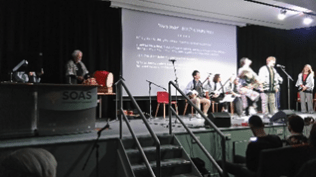
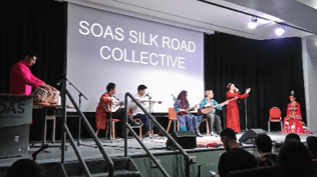
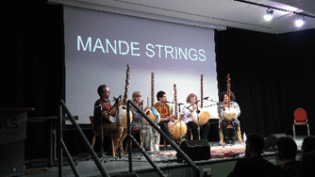
The second report is about the Tsugaru Shamisen students’ concert. I wrote about last year’s concert on these pages. It is an annual event organised by the Tsugaru Shamisen instructor, Mr. Hibiki Ichikawa. The event was held in a north London district where there’s a large Japanese community, it was the fifth time the concert had taken place.
The event included many advanced students who had come all the way from Berlin. There was also a special guest for this year, Mrs. Yoshie Campbell, a specialist in singing and dancing Japanese traditional folk music. She joined in on a number of occasions and closed the event. It was a happy night, listening, in London, to the sound of powerful Tsugaru Shamisen and the singing of Japanese folk tunes.
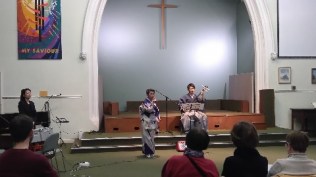
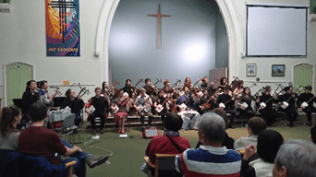
The third report is about an event presented by the SOAS Centre of Buddhist Studies and The Department of Religions and Philosophy. The main organiser of the event was Dr. Lucia Dolce who has been a chair of both The Centre of Buddhist Studies and The Centre for the study of Japanese Religions. Dr. Dolce had invited Mr. Akinobu Tatsumi a 17th generation monk from Jodo Shin shu, the Honganji sect Seiryusan, Shosanji temple, Japan, to the event. The aim of the occasion was to experience a new method of spreading the teaching of Buddha.
In the first half, Chief Priest Tatsumi, presented new Buddhist music to the audience. It consisted of self-produced pieces which mixed hip-hop with dance music and Buddhist chanting. His aim is to propagate Buddhism to the modern generation by combining contemporary sounds and Buddhist teaching. In the second half, Chief Priest Tatsumi talked about his experience of participating in the Goma ritual (fire-offering ritual) at a temple in Kikuchi city, Kumamoto prefecture where all the members were female mountain ascetics. He also explained, using photographs, the purification practices involved in preparing himself for the Goma ritual.
Mr. Nick Cantwell followed Chief Priest Tatsumi with a talk. He is a musician, writer and film maker who has produced a film called Kanzeon and been on a pilgrimage to Shikoku. He discussed how sound affects one’s perception of the visual and spiritual from a religious view point.
After these fascinating talks, there was a session of questions and answers featuring a panel which included Dr. Lucia Dolce, Dr. David Hughes, Chief Priest Takumi and Mr. Nick Cantwell. It was an innovative event which taught us about a novel and new approach to religion.
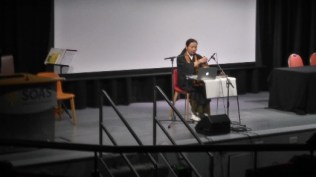
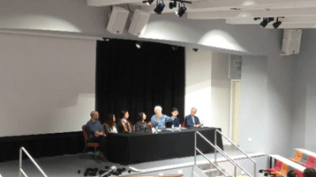
January Activity Report
31 January 2019
Global Japan Office Coordinator
Taguchi Kazumi
Happy New Year.
The first London report of 2019 concerns a talk held at the Daiwa Foundation titled “Industry – Academia Partnership: Collaborations between UK Universities and Japanese enterprises”.
The speakers were the CEO of Dojima Sake Brewery UK & Co. . Ms. Kiyomi Hasimoto and Keidanren Professor of Japanese Studies at Cambridge University, Professor Mikael Adolphson.
The first speaker was Ms. Kiyomi Hashimoto who introduced the Dojima Sake Brewery. The company set up its business in a little historical town called Fordham Abbey outside Cambridge in 2018, from where it began to operate its business in the UK and the world. The Dojima Sake Brewery has its origin in the Dojima Beer brewery in Osaka set up in 1996 by Ms. Hashimoto’s father, Mr. Yoshihide Hashimoto who was the second son of the fifth generation of the Kotobuki Shuzo family brewery from the Settsu Toda region in Kansai. They are the first Japanese enterprise to set up a Sake brewery in Europe.
The Dojima Sake Brewery mainly produces two types of Sake, “Dojima” and “Cambridge”, both sakes are branded as high-quality and cost £1,000 per bottle.
Ms. Shimizu explained that in order to energise the Sake market it was necessary to educate and promote the pure taste of Sake to wine enthusiasts around the world who enjoy fine products. Taking into account the raw materials, environment and skills involved, they have come up with the current price.
The Dojima Sake Brewery is planning to offer lectures on the history of Sake and Sake making process so as to enable local people and people from Europe to appreciate Sake. The company also has plans to set up a café and restaurant next to the brewery. Local sake brewing in the UK has been born. It will be exciting to see how it develops in the future.
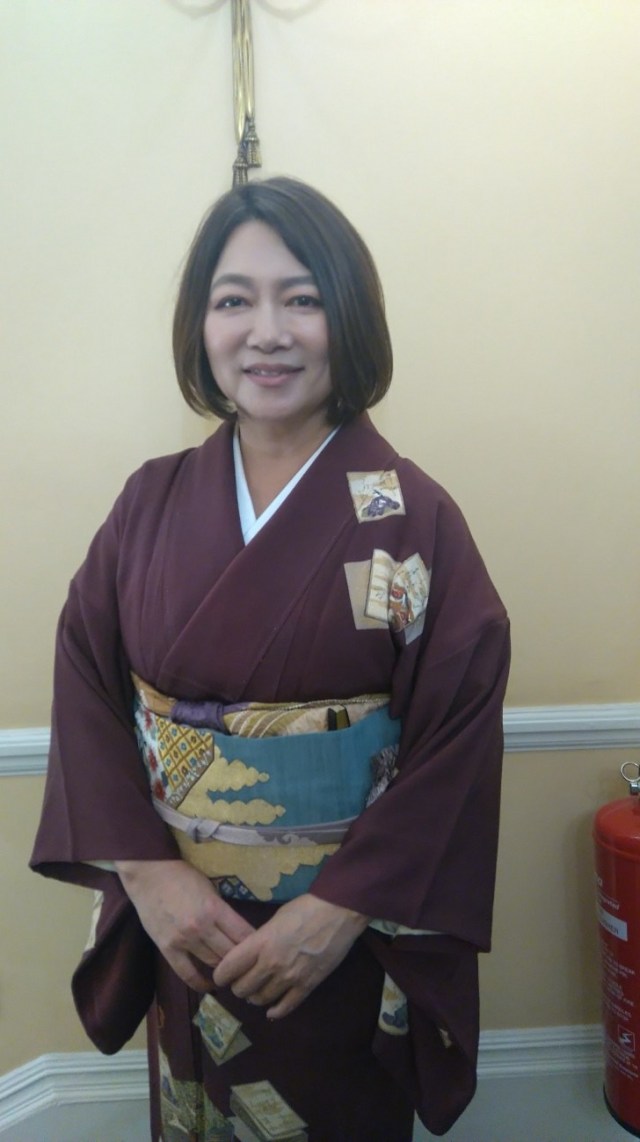
The institution supporting the development of the Dojima Sake brewery in the UK is Cambridge University.
The second speaker of the evening was Professor Mikael Adolphson, who began his talk explaining that the Cambridge University’s Japan Studies department was in a critical condition and on the verge of closing down. The reason for this is that funding in certain sections of academia is decreasing. On one hand, the Art, Humanities and Language faculties are having their financial support curtailed, on the other hand, the Science, Technology, Engineering and Mathematics Departments are strongly supported financially. As a result, institutions have become places primarily aimed at training for jobs rather than nurturing students to become reliable citizens who are capable of critical thinking and innovative ideas. The following problems and solutions were presented by Professor Adolphson.
According to the statistics, what companies are looking for from graduates are; 1 critical thinking/ analytical reasoning; 2 ability to analyse/ solve complex problems; 3 effective oral communication; 4 effective written communication and in 5th position, the ability to apply their knowledge/skills to a real-world setting.
As far as Japanese Studies are concerned, the graduation certificate in Japanese Studies doesn’t directly connect with a career after graduation. The main reason for this is a lack of research collaboration. The first point is that there is no Cambridge Research on Japan engaging with or in Japan. The second point is that it is a challenge for Japanese Industries to get involved in research at Cambridge. As a result, there is currently no Japanese research and innovation taking place at Cambridge University.
The Japanese Studies graduates at Cambridge have a high level of using and understanding Japanese and they spend one year on their third year of study in Japan. They are fast learners, capable of taking leadership and have a broad level of knowledge. Currently more than 80% of graduates get jobs with no connection to Japan. There is little reason for Japanese Studies to exist, if students can’t get a job related to Japan. Therefore, there has been a decrease in demand for learning Japanese. One of the reasons that they can’t get a job connected to Japan is that there is a lack of graduates gaining work experience in Japan.
In order to find a solution to this situation, Cambridge University has formed partnerships with some Japanese enterprises. One of them is the Mitsubishi Corporation.
Japanese Studies at Cambridge University has shifted its focus from Area to Multi-Disciplinary Studies. This is because there is a need to produce new knowledge and new scholars. In order to create this background, we need to have established scholars with a superb understanding of Japan. To be able to offer this, there should be a central axis providing understanding of Japan in a constructive way. However, there is hardly any interest from industry and government.
There is a need to train the next generation of scholars and innovators. Currently, there is no financial model for training graduate students at UK Universities. There is no future for Japanese Studies without new scholars. It is important for graduate programmes to get support from external sources however it is difficult to form partnerships due to the cost. We need to evaluate common interests, a way to ensure partnerships and value for support.
Regarding Research Collaboration: in the case of Europe and North America a lot of R & D happens in the Universities therefore it is common to have collaboration between Industry and Academia. However, in Japan, much of the R & D takes place within companies.
The long-term solution, is to have a venue which facilitates collaboration, support of scholarship, innovation and research activities. The idea is to set up an academic centre for global research which takes advantage of Japanese initiative. Through this process, there is an opportunity for Japan to take the lead in addressing environmental, social and international issues. The Centre for Global Research at Cambridge Japanese Studies is ready to commit to this enterprise.
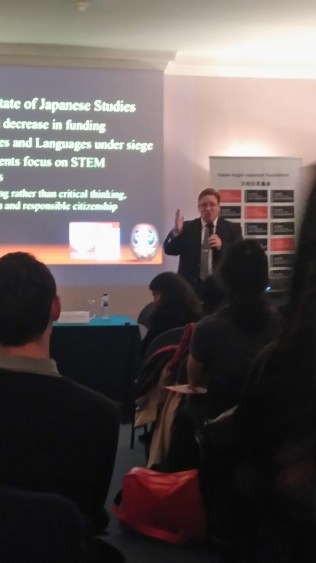
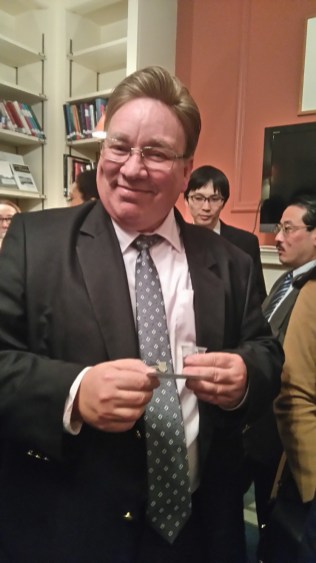
December Activity Report
5 January 2019
Global Japan Office Coordinator
Taguchi Kazumi
For my December London Report, I am going to write about an artist, Ms. Kawai Ricca, who is based in London and who puts a lot of energy and thought into creating her fascinating works.
Ms. Kawai exhibited her works along with two other artists in a gallery in an area called Angel which is well known as being a fashionable district and is popular with Londoners who enjoy eating out and shopping.
Ms. Kawai graduated from The Musashino Art University. Moved to London in 1987. Ms. Kawai then studied advanced life drawing course at St. Martin’s School of Art. From 1989 to 1991 she worked at Pentagram Design whilst continuing to work as an artist creating her pieces. She has put on many exhibitions over the years.
In 1995, Ms. Kawai was awarded the Goto Memorial Foundation Culture Award. In 2017, she received a grant to take part in an achievement after training abroad exhibition and visited Japan as an artist in residence in Yokohama where she produced art works for this special show. The result of her stay was a display of her work at the Nap Gallery from January to February 2018, entitled “Weight of Light”. Ms. Kawai talked to me about the theme of the work she created for this show.
“The exhibition is about migrating to another planet as the earth is in danger of no longer being able to sustain life.
Since I was a child, I have been fascinated by the mysterious sense of existence and those regular movements created by nature which you can’t see with your eyes. The theme of my recent works has been a visualisation of the vast area of the invisible world existing in the universe. In order to achieve this, I used transparent pictorial material/support, which was then reflected through light. The effect is the co-existence and interaction of two opposite elements, light and shadow, I named this Photoskiagrafia. This word is derived from Greek words, Photo (light), Skia (shadow) and Grafia (picture). I am also exploring the possibility for the meditative state lead by having optical complex made by casting light to the image created by transparent material and the mirror. “
Ms. Kawai only exhibited two pieces so I am looking forward to seeing her creations in a larger space and enjoying seeing her in action as she produces these thought-provoking pieces.
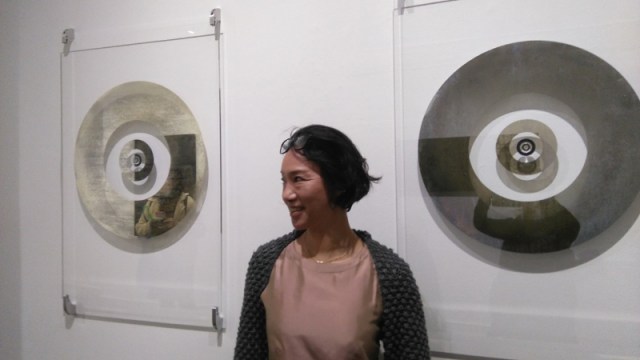
The Portal is based on Titius-Bode law, the sequence corresponding to the distances of the planets’ orbit from to the Sun
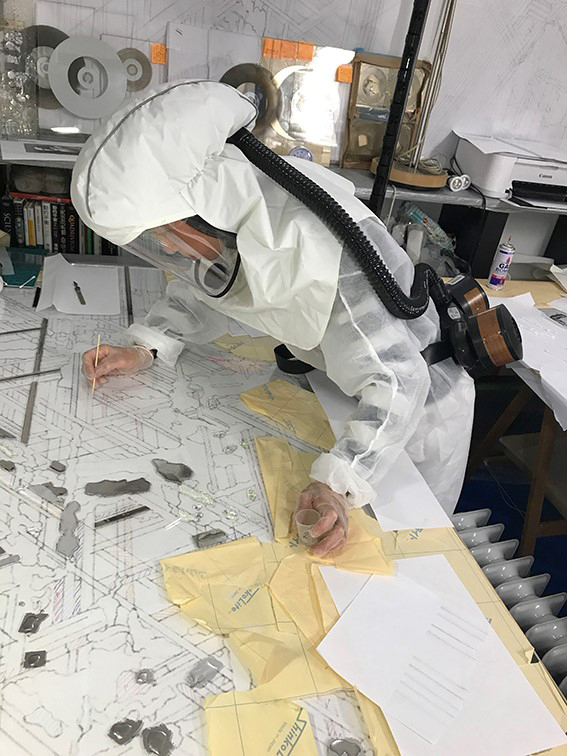
Air respirator needed for the toxic material she use.
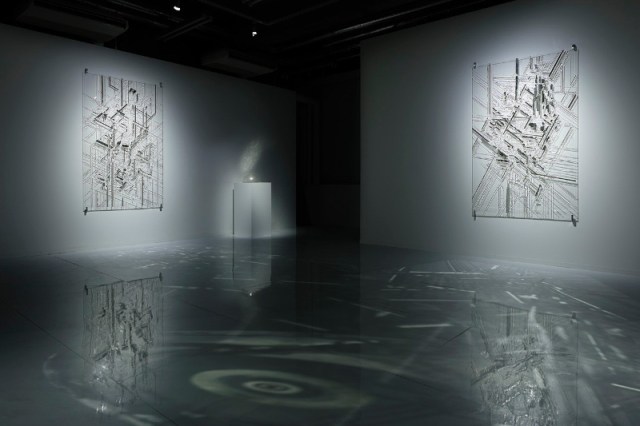
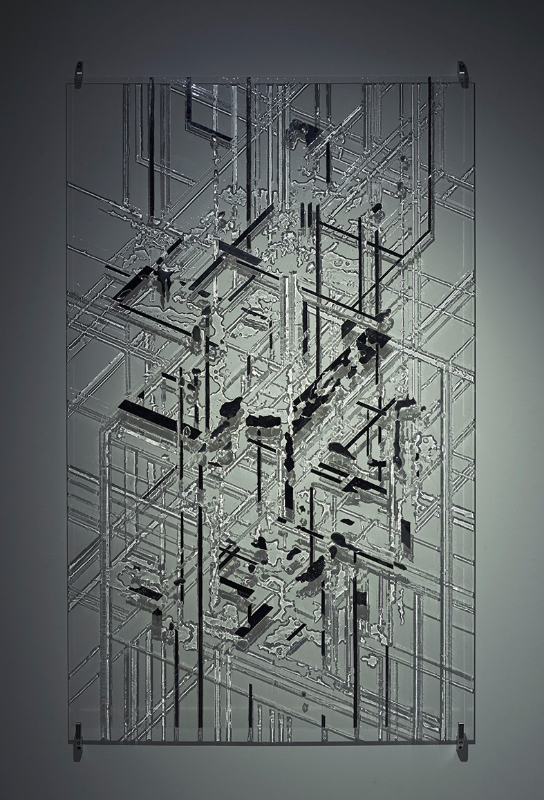
November Activity Report
30 November 2018
Global Japan Office Coordinator
Taguchi Kazumi
For my November London report, I would like to write about the talk Dr. Daisuke Shinagawa presented at the SOAS-BFSU Joint Conference organised by the London Confucian Institute SOAS. Dr. Shinagawa works at AA-Ken (The Research Institute for Languages and Cultures of Asia and Africa). Dr. Shinagawa visited London for a short period of time this Autumn furthering his research.
The Conference took place at the Alumni lecture theatre in the new building of SOAS, Paul Webley Wing. Dr. Shinagawa’s talk was the second of the second half of the morning talks. The title of the talk was ‘Linguistic diversity and unity in Swahili contact varieties: a shared element not attested in “Swahili”’. Dr. Shinagawa’s speech was given in English and using slides as a visual aid concerned his research on the Swahili language. It was a really fascinating talk. After the talk, there was time for questions and answers. There were many interesting questions from different viewpoints which gave the impression that the audience consisted of people from many different academic disciplines.
Dr. Shinagawa was only in London for two weeks. However, he was active all the time organising meetings, presenting a talk on his research, and receiving a visitor from Germany with whom he arranged the materials for their joint research to be published in a journal. It seems his short visit to London was very fruitful.
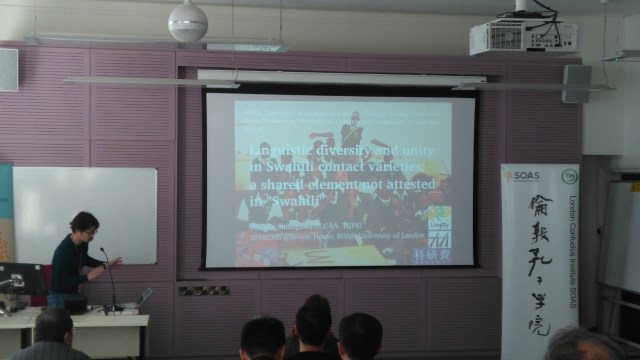
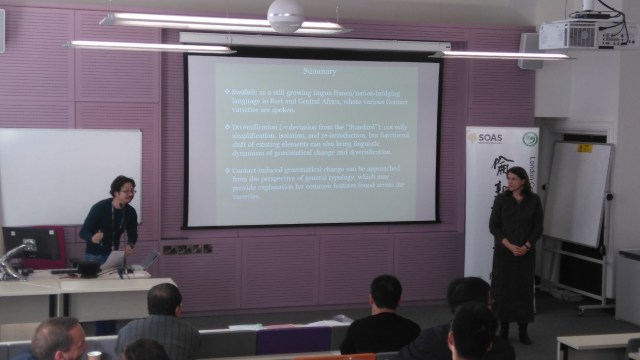
For my second topic, I would like to write about my visit to Dr. Christopher Gerteis’s office at SOAS to get some opinion and advice about the relationship between TUFS and SOAS. As many of you may already know, Dr Gerteis is a member of The Consortium for Asian and African Studies (CAAS). He stayed and taught at TUFS from October 2016 to Spring 2017.
Dr. Christopher Gerteis is a Historian of Modern and Contemporary Japan, and he teaches an introductory course for East Asian history as well as Modern Japanese history which is divided into two levels giving an option for students who want to study the subject in more depth. Dr. Gerteis also supervises PhD students. He will be visiting TUFS next spring.
One piece of advice that I received from Dr. Gerteis is that in my London report I write about the many language courses on offer from SOAS, as TUFS students who are learning foreign languages are keen to know what kind of languages are taught in universities in other countries. It is a very good idea indeed.
Next year I will do my best to write about the many language courses SOAS has on offer.
Britain is preparing for the Christmas fever. It is getting colder day by day, but the people and the streets are gleaming despite the endless problems associated with Brexit.
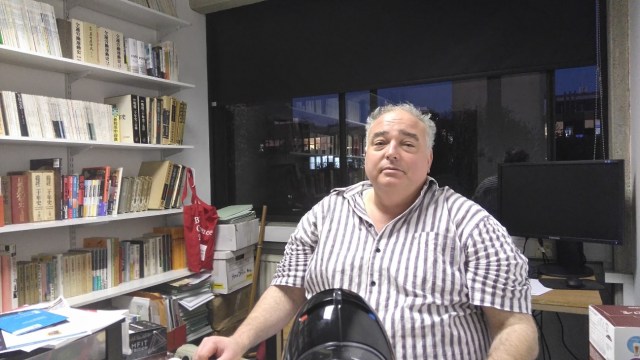
October Activity Report
31 October 2018
Global Japan Office Coordinator
Taguchi Kazumi
The first item in the October London report is about a play titled “The Art of Gaman” which tells the story of a Japanese woman who lived in America during the Second World War. It was staged at a small theatre called ‘Theatre 503’.
This production was put on by a freelance producer/director, Helen Milne, and was supported by the Art Council, England, The Daiwa Foundation and The Unity Theatre Trust.
Theatre 503 is passionate about developing new writers. They offer the opportunity to convert potential scripts into theatre plays. They focus on finding new talents and developing them to become the leaders of the next generation.
The playwright, Dipika Guha who was born in India and raised in England and Russia, has a Master in Fine Arts from the Yale School of Drama, and is currently a Hodder Fellow at Princeton University. “The Art of Gaman” was one of six shortlisted for the American Playwriting Foundation’s prestigious Relentless Award. Dipika Guha is an individual who is producing many culturally influential plays.
The story begins with the protagonist Tomomi (performed brilliantly by Tomoko Komura) returning to America to live with her parents who are both Japanese. As a background, Tomomi was brought up in America, but was sent to Japan to be educated in the Japanese system. The war breaks out whilst she is staying in Japan.
Tomomi’s dream is to become an actress. However, when she arrives in America, she finds out that her parents have been sent to a prisoner of war camp. Tomomi works as a cleaner while dreaming to one day become an actress. But, due to immigration issues, she ends up getting married to the son of an old acquaintance.
The play tells how Tomomi has to be patient in order to survive in America. In the end she finally discovers what sort of person she really is.
The play’s programme summarises the story as, “The Art of Gaman is an aching exploration of displacement and loss of cultural identity when you find yourself in a country that considers you an enemy. When forgetting your past is shameful, but remembering brings even greater pain, Tomomi must harness the strength to find beauty in the struggle and carve out a new life for herself and be true to who she really is.”
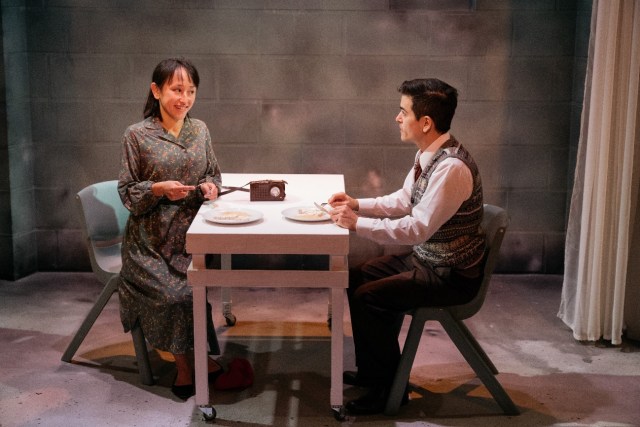
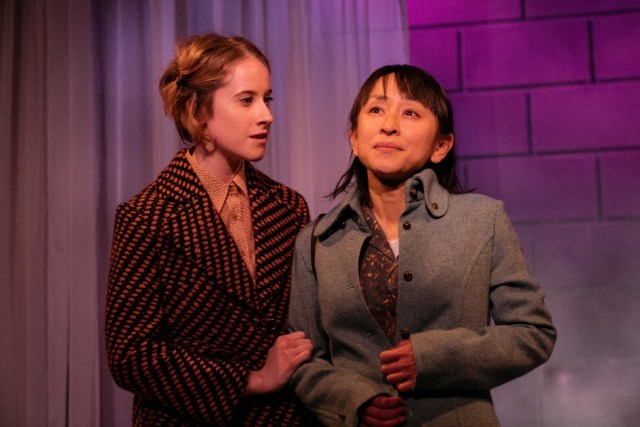
The second part of the report is about a rehearsal of the BBC Concert Orchestra which features the talented and talked about percussionist, Beibei Wang, who I wrote about in the June London report concerning the SOAS world music day. Beibei Wang was preparing for a tour of China. Luckily, I had a chance to witness the final rehearsal before she and the musicians departed.
The BBC recording studio is situated in the midst of the up-market residential area of Maida Vale, which due to regional development by property developers, is soon going to move elsewhere after being in its current location for a long period of time recording music by many talented musicians.
The picture below shows the home of the BBC Orchestra, where both recordings and rehearsals take place. Being a recording studio, the sound was magnificent. As the picture shows, there were many flightcases for the instuments lying around in preparation for the travel logistics after the final rehearsal.
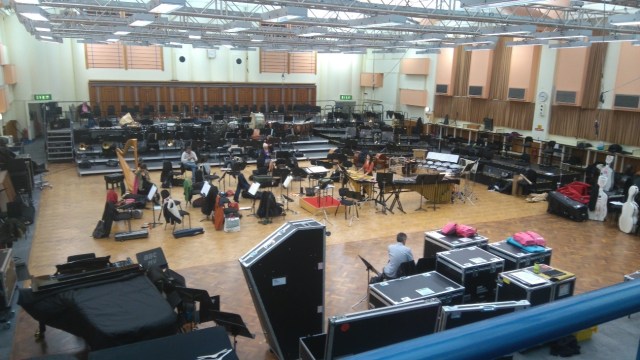
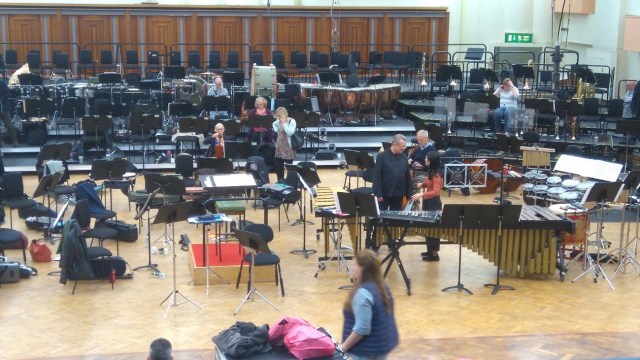
The rehearsal began with the BBC Orchestra playing pieces from their repertoire. Despite just being a rehearsal, it was an emotional experience listening, at such close quarters, to a live performance from top professional musicians.
After that, it was time for Beibei Wang to play her pieces. Beibei Wang graduated from both the Central Conservatory of Music (China) and the Royal Academy of Music (UK). She has done many workshops in the UK, Europe, America and China, and played and collaborated with many musicians from all over the world.
As far as Japan is concerned, she has collaborated with the New Japan Philharmonic as well as touring with Aragumi Daiko who have their base in Belgium. Beibei is keen on incorporating many different musical genres such as Chinese traditional music, ethnic music from all over the world, Western classical music, jazz and pop, all of which contribute to making her musical activities dynamic and diverse. Lately, she has worked with a Chinese fashion designer providing music for the catwalk at London Fashion Week. She is a truly energetic lady.
The piece she played with the BBC Philharmonic is titled “The Tears of Nature” and consists of three movements based on three devastating natural disasters: an earthquake in China, the Tohoku disaster and an American tornado. It was a moving performance expressing the beauty and eerie character of nature. With a bit of luck Beibei Wang will soon be giving a performance in Japan. I sincerely hope so.
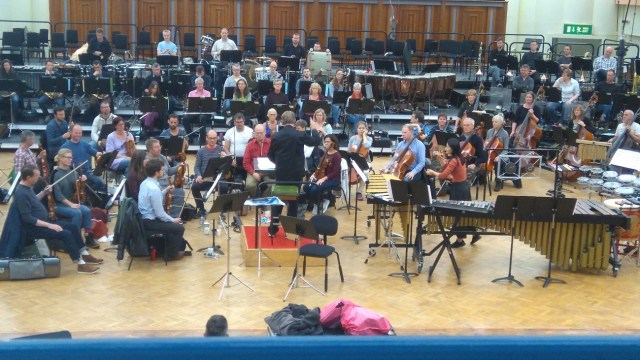
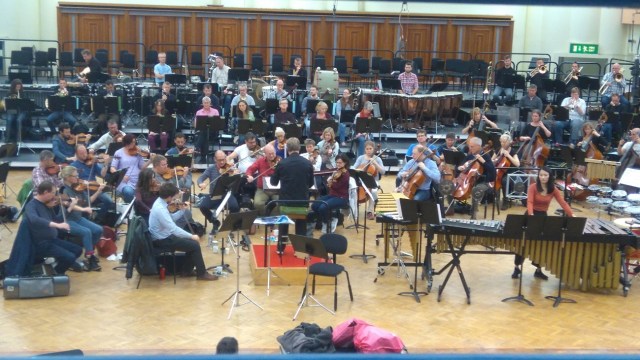
September Activity Report
30 September 2018
Global Japan Office Coordinator
Taguchi Kazumi
For my September London report, Dr. Nathan Hill who is head of the East Asian Department has agreed to my request for an interview. Dr. Hill is very keen on participating in TUFS activities at SOAS, and has attended all of the TUFS-SOAS friendship meetings over the last two years.
Dr. Nathan Hill has worked at SOAS for the last ten years. He spent his first three years teaching the Tibetan language. After that, he became a researcher as a post-doctoral fellow for three years. Then, he became head of the department of East Asian language and culture.
Until one year ago, the department of East Asian language and culture was divided into two sections: Japan & Korea, and China. But there was a view that it would be better to put all the East Asian studies into one. Hence, China, Tibet, Korea, and Japan came under one umbrella. The idea is that the four different nations are considered as one cultural entity. The ideal environment for the study of East Asian culture and language according to Dr. Hill is one in which Chinese Classical literature is one of the starting points for understanding the region’s cultural and linguistic heritage.
SOAS was the first educational institution in the UK to implement a system of sending students abroad to study their selected subjects; an innovative idea for its time. Over the years, many universities took up this system and it has now become the normal thing to do. According to Dr. Hill, it is time to change the current SOAS system of studying a year abroad for a new one, as the original system is dated and needs to be renewed.
Currently, SOAS students only have a choice of studying abroad for a year. The ideal for Dr. Hill would be as well as this to set up a system of SOAS students studying a shorter time abroad. He believes that each student should have the opportunity to learn and experience cultures of their choosing directly, this would lead to a deeper understanding of their field of studies.
The following statement is the introduction to the Department of East Asian Language and Culture by Dr. Nathan Hill:
“Demand for specialists with advanced proficiency in the languages of this region has significantly increased in recent years. We offer more or less intensive study of East Asian languages, both at SOAS and at our many prestigious partner universities.
The cultures of China, Japan & Korea have become increasingly familiar to Western audiences over the course of the twentieth century. TV shows and film, food, fashion and computer games, Manga and anime, K- and J-pop, have become an important part of global popular culture. Many also continue to be drawn to the rich diversity and dynamism of East Asia’s pre-modern literary, religious, artistic and philosophical traditions.
Our expertise allows you to gain specialist knowledge in the regions of your interest, in their classical traditions as well as their contemporary developments.”
London is a city which embraces multi-culturalism and diversity. In this open environment, where the differences between people are appreciated and valued, East Asian culture has no trouble in thriving.
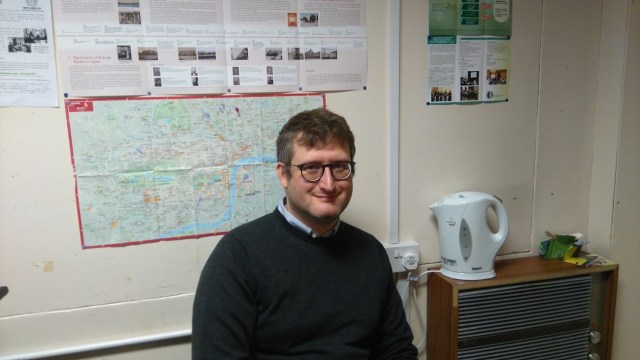
August Activity Report
31 August 2018
Global Japan Office Coordinator
Taguchi Kazumi
For my August London report, I am going to talk about some of the societies managed by the SOAS student union.
As regards club activities, they are categorised into two major groups: Sports Clubs and Societies. Amongst the many kinds of societies existing, I will talk about societies related to Japanese culture.
There are four different Martial Art societies. One of them is the Airenjuku Aikido Society. This society was established twenty-one years ago and has been going strong at SOAS ever since. The second Martial Arts society is the Shin Shin Toitsu Aikido. It aims to practice developing Ki and teaches breathing techniques using Ki.
Both of these Aikido societies respect harmony. They practice developing mental and physical strength and spirituality using the concept of harmony as a base. At the same time, they practice self-defence. The important concept behind Aikido is not that of fighting with an opponent but that of co-working with an opponent and developing together through practice. It is not an aggressive or competitive sport, and is open to any age group and physical size to join and practice. It is ideal for maintaining health, flexibility, core strength, body coordination, and reaction.
The third martial arts group is the Japan Kenpo Society. This society is little known at the moment. It is dedicated to a modern physical fighting sport developed through scientific research. Protective armour is worn to avoid injuries. The fourth group is the Shorinji Kenpo Society. This martial art aims both to develop self-defence and self-development. It is a self-defence technique using Eastern philosophy and meditation, which at the same time, teaches self-discipline and awareness by co-operating with people and helping each other.
Japanese Animation is well established and popular in the UK. SOAS has its own Anime Society. Their main activity is to get people who are big fans of Animation and Manga to meet up every week and watch Anime together.
The next society to introduce is the Studio Ghibli appreciation society. The society aims “To invite and unite students together in the appreciation of the world-renowned animation studio, Studio Ghibli”. There are many Miyazaki fans all over the world now. The society furthers the appreciation of the stories, animation art works and concepts of the fantasy collections created by Studio Ghibli.
Surprisingly, there is also a society called In-Yo: Kissaten by day, Izakaya by night. As the title says it is a café (Kissaten) in the afternoon and changes to a bar at night. A selection of Matcha, Japanese green tea, Sencha, Hojicha, Genmaicha and others is available at the Café. They also serve delicious smoothies. There are choices of traditional Japanese Sweets (Wagashi) as well. In the evening, it changes to a bar (Izakaya) and there is a selection of drinks such as Japanese Sake, Japanese whisky, Shōchū and Sake cocktails on offer, as well as tasty snacks. There are some interesting activities as well. They offer Sake tasting and talks, board games, live performances, film, an Onigiri making workshop and Karaoke if requested. In-Yo Kissaten and Izakaya seem to be bursting with ideas.
The reason for calling themselves Yin-Yang Kissaten/Izakaya is explained by them as “We chose the name In-Yo (Yin-Yang), because we would like our members to feel free to be active or passive, according to where they are in their work-rest-play cycle. In practical terms this means you can either simply be entertained and enjoy our high-value, high-quality refreshments, or you can devise and deliver your own idea/ mini-project, or volunteer to wo/man the bar or cafe. In this way the offering can be co-created and co-delivered by and for the group. “It sounds a real ‘chill out’ place, as Londoners say.
Another classic association is the Origami society. Origami culture has been firmly established in the UK for some time now. The SOAS Origami society has its own uniqueness and aims to develop skills including “imagination, creativity, memory, dexterity, patience and geometry.” They encourage the development of Origami art and have a number of projects on offer which are available to all levels of skill from beginners to advanced.
Next, we have the Japan Society. The SOAS Japan Society meet regularly and are currently planning to have language exchanges and put on film screenings and various cultural events.
There is also a society called the J-Pop Karaoke Society. Unfortunately, there is no information available on this group.
There is a SOAS Minyō Group as well. As you may already know, this group is formed and managed by Dr. David Hughes. This society is open to anyone (including non-SOAS members) who is interested in Japanese traditional folk music. They practice every Saturday. They are a very popular group and participate in many cultural events related to Japan all over the UK. Recently, they have started to perform accompanying plays. It is a very energetic and musically excellent group.
SOAS has its own radio station as well.
The societies mentioned here are the ones related to Japan. As you can see, there are many unique societies at SOAS. The nature of a society is that students plan, start up, and manage the society by themselves. In order to form a society, you need to have six like-minded people prepared to get ideas together. It is an ideal place to learn how to develop ideas and practice sharing and cooperating with other people before entering the professional world.
July Activity Report
31 July 2018
Global Japan Office Coordinator
Taguchi Kazumi
For the July London Report, I am going to write about the visitors from TUFS to SOAS. Universities in London go on a break in June for the summer holidays which last for four months until September. The students and most of the teaching staff are having a holiday and have left the campus (except MA students who begin writing their individual dissertation). Although the university has broken up for the summer, it doesn’t mean the university is closed. On the contrary, it is the beginning of various summer courses which are open to external students who visit SOAS from all over the world. One example is the music summer course which I talked about in my June report. Many students from TUFS visit SOAS in the winter and the summer every year for a short study visit.
Every year one member of the administrative staff who works at TUFS attends the Staff Learning and Development programme. This year, we had Ms. Tomomi Kikuchi from the Academic Affairs Division. The programme consists of three- weeks intensive English learning and one-week work shadowing. I saw her a few days after she began the English course. According to her, it sounded like it was a very demanding course with a tight schedule and a lot of homework. She had to give a presentation in front of the class at the end of her stay, and because of the demands of the programme there was little time for sightseeing. However, it was a very satisfactory course. Work shadowing aims to give the participant experience in different departments of the SOAS administrative system. Ms. Kikuchi said she enjoyed the programme and learnt a lot from the experience.
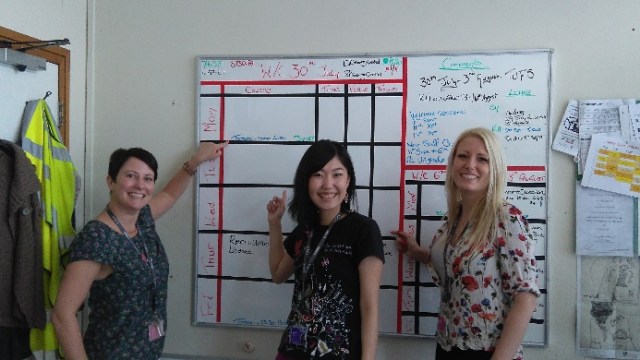
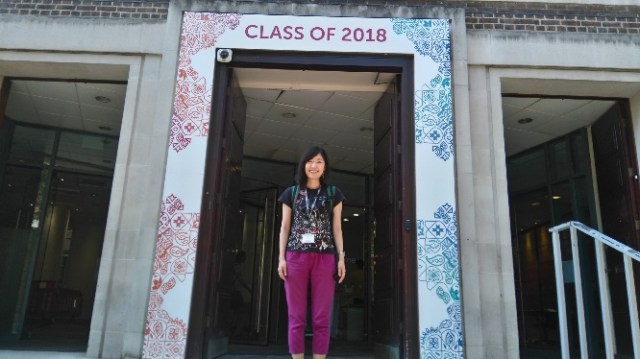
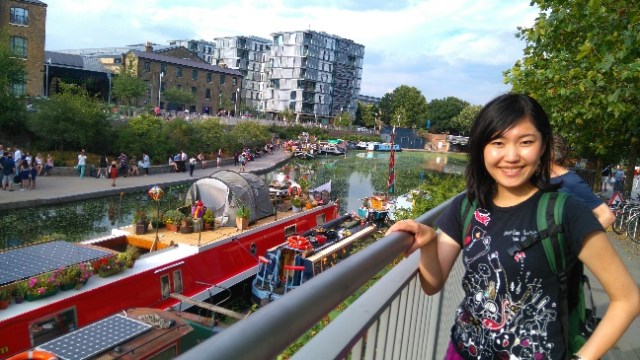
The second visitor was Assoc. Prof. Kenji Okano whom I introduced in the March report. He is a researcher in the Burmese language and teaches at TUFS. Assoc. Prof. Okano stayed for six months in his previous visit and this time he will be researching at SOAS for two months. He was involved in setting up the TUFS office at Yangon University in the past and is currently involved in creating the Burmese language database. Assoc. Prof. Okano is very passionate about his work in the development of the Burmese language.
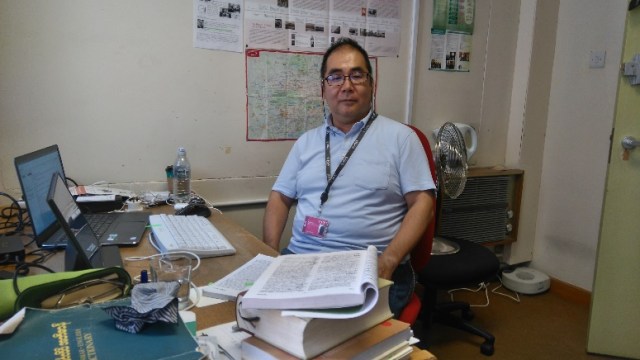
The third visitor was Assoc. Prof. Shintaro Arakawa. Assoc. Prof. Arakawa researches the Tangut language at The Research Institute for Languages and Cultures of Asia and Africa. He has visited SOAS as a visiting scholar in the past and when he was here last time he kindly joined our TUFS-SOAS friendly event. It was on a short visit of just a week this time in which he was extremely busy with research. Assoc. Prof. Arakawa is a good friend of Assoc. Prof. Okano and I had an opportunity to join them at a Greek restaurant to celebrate their reunion in London. I had a very enjoyable time in their company.
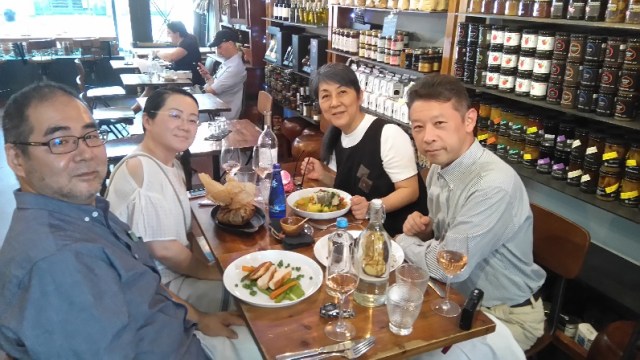
July is the graduation season. Recently the SOAS graduation gown has been renewed and become exclusive to SOAS with its own colour. Many students wearing the grey gown with yellow hood passed by with a big smile on their faces.
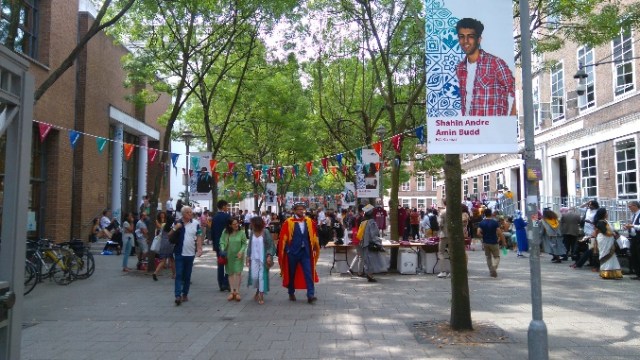
June Activity Report
30 June 2018
Global Japan Office Coordinator
Taguchi Kazumi
The examinations at the end of academic year have finished, and a relaxed and energetic atmosphere has returned to the campus once again. This year, we have had continuous hot summer days in London. The summer in the UK, unlike the hot and humid Japanese summer, is not humid, so you can cool down when you go under the shade and feel dry. For this month’s report, I am writing about the Japan’s ethnical minority cultures (Korean, Chinese and Okinawan) in London.
On the first Saturday after the end of examinations an event was organized by various Korean societies in which students were able to learn about different types of musical instruments and singing and dancing. I wrote about it last year, so some of the readers are already familiar with this event. I managed to find time to rejoin the Korean drumming society. It was a very enjoyable evening.
Korean societies are very active and feature Taegum (bamboo flute), Gayageun (zither), Pansori (singing and storytelling), Korean traditional dance and Samur nori (Korean drumming). There is a choice of beginners’ class and advanced class. All the students from the society were involved in making the event successful, and it was a very professional presentation.
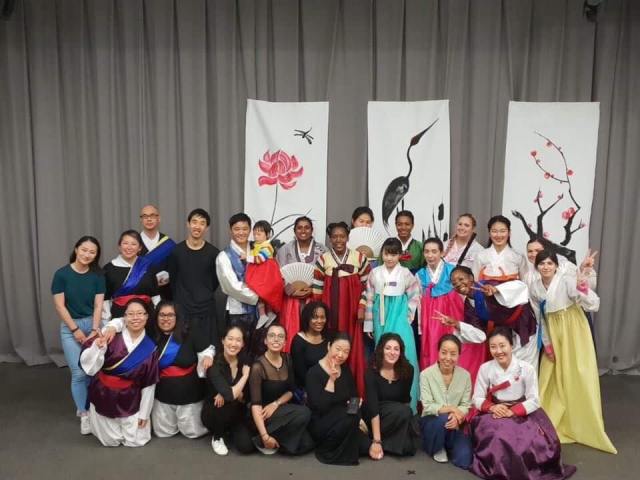
The Wednesday in the second week of June was SOAS music day. During the day, music from all over the world was played on the campus. It is an event that signals the end of the year at the same time advertises the beginning of the SOAS music summer courses. For two weeks, there are music summer courses organised every year open to the general public as well as students.
Unfortunately, it was my work day, so I can not give a full report of the event. I did however see some performances of Chinese music while I was passing by. One of the performances was given by the SOAS Chinese Traditional Folk ensemble led by Dr. Hwee San Tan who received a PhD in music from SOAS. It is an ensemble consisting of Pipa, Urhu, Sanshen, Gujen, percussive instruments and flute. There was also a performance of accompanying music in the style of the Beijing Opera. It was followed by Ms. Beibei Wang who is a graduate of RSM and teaching Chinese percussion at the SOAS music summer course, who performed powerful drumming with her students.
When I was leaving the building, I saw a big band orchestra playing Cuban style Latin music (although I am not certain) with singers, creating a carnival-like atmosphere. I thought music from all over the world was played throughout the day. It was just like a Midsummer Night’s Dream.
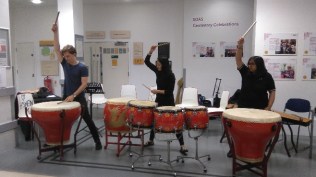
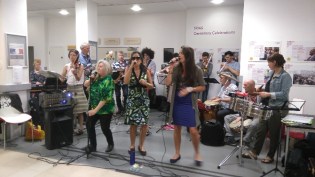
The third report is about Okinawa day which is associated with Okinawa Memorial Day, something I wrote about last year as well. It is the tenth anniversary, so there was a special program in which musicians from Japan were invited. The event started with the most well-known and important classical tune, Kajadefu, with singing and dance, and was then followed by folk music from Amami Oshima, various styles of Okinawan folk songs, music mixing Okinawan and Reggae by Kanako Horiuchi, Tsugaru Shamisen by Hibiki Ichikawa, folk music from Miyakojima, Okinawan Tea Ceremony-Bukubuku cha, and Eisaa performance. Dr. David Hughes was there of course busily participating: playing drum, Sanshin, sanba and singing.
Local Karate groups participate every year demonstrating various Karate forms and exercises. The young Karate masters’ movements are very cool. I am grateful to the members of London Sanshinkai who organise the event every year and many volunteers who help provide such a pleasant time and ensure the event runs smoothly. When I closed my eyes and listened to the sound of Sanshin, even in the middle of the busy Banking district, I felt I was close to the sea. I am looking forward to next year’s event already!
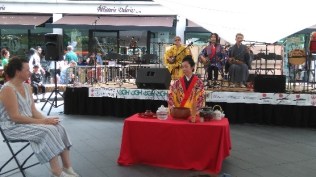
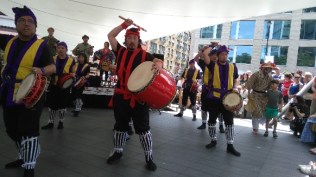
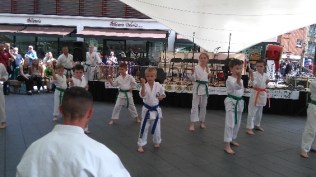
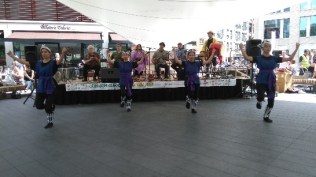
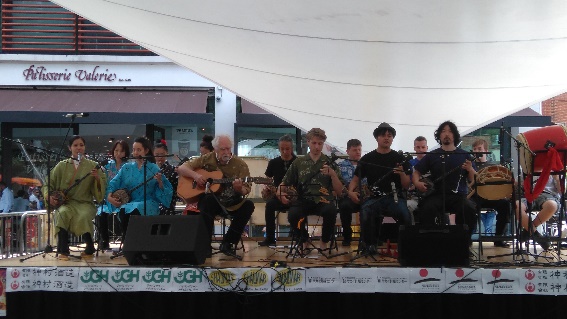
May Activity Report
31 May 2018
Global Japan Office Coordinator
Taguchi Kazumi
Final exams take place between early May and early June in UK Universities; the campus is very quiet and one can feel the tension in the air. The usual format an examination is that you have to choose four questions and answer them within three hours (language courses are an exception) in essay form. It obviously requires a lot of concentration. It is also physically exhausting, as one has to write by hand continuously for three hours. When you are under stress, it can cause a huge strain to your mind. So, the Student Advice and Wellbeing Service operated by the Student Service Department offers classes such as hypnotherapy, yoga and relaxation classes for the students to cope with the pressure.
It is the end of the academic year in the UK universities. In contrast, the new academic year started in April in Japan and I am sure that students have by now settled in to the classes and lectures. I heard that Dr. Philip Seaton who started teaching at TUFS from this April was visiting SOAS. Despite his busy schedule in the UK, Dr. Seaton kindly agreed to talk to me for a short time.
Dr. Seaton has lived in Japan for more than twenty years, and taught at Hokkaido University for fourteen years before he moved to TUFS. He is affiliated with the Institute of Japanese Studies at TUFS. Dr. Seaton’s special areas of research are Media, Culture and Tourism Studies, focusing on War Memories.
Dr. Seaton’s main reason for visiting SOAS this time was to explore the possibility of setting up a dual degree program between SOAS and TUFS. Dr. Seaton said that it was only the starting point and it was difficult to say at this point in time how the project would develop in the future.
Currently, students from TUFS come to study at SOAS either for a short-term study abroad in winter or summer or for a year-long study abroad. We look forward to the future development of this program.
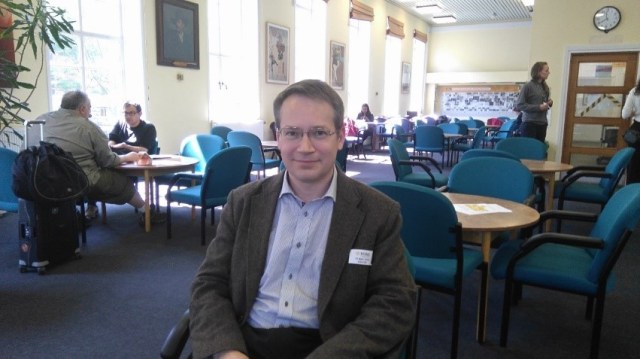
April Activity Report
15 May 2018
Global Japan Office Coordinator
Taguchi Kazumi
For this month’s report, I would like to introduce the SOAS Centre of Translation Studies which features the translation of Japanese among the courses it offers, something which directly relates to my report of play reading in March.
There is a course called MA Translation in the School of Language, Culture and Linguistics. MA Translation are also a part of the activities of the Centre of Translation Studies (CTS).
I visited Dr. Nana Sato-Rossberg (Sato Sensei hereafter), who is the Chair of the SOAS Centre for Translation Studies.
Sato Sensei has been teaching at SOAS for the last four years. She previously taught at the University of East Anglia (where Mr. Kazuo Ishiguro who won a Nobel Literary prize did his MA in creative writing) for three and half years.
Sato Sensei explained that Translation Studies was begun in the Europa in the 70s and advanced rapidly in the 90’s in the UK. The SOAS Centre for Translation Studies was established in 2008 aiming to promote translation studies of non-European languages and cultures. Currently, there are MA and PhD courses available at SOAS.
The compulsory subjects for the MA in Translation are Translation theory, Translation study and methodology, and a dissertation which is a translation project or translation theory.
According to Sato Sensei, one immediately thinks that translation means that there is a source text and then a translation. However, Translation Studies are more complex and involve much more than practical translations. In academic terms, for example, it means becoming aware of the translation process taking place in one’s brain during translation. Students learn translation processes through theory and method.
When translating, there is always a choice of words and style. To be able to choose suitable words and style for the text, an understanding of different cultural backgrounds is required.
Currently, there are 24 students learning Translation Studies. Students are free to choose their desired language/s. There is a choice of 7 languages pairs; Japanese, Korean, Chinese, Arabic, Swahili, Turkish and Persian (from/into English). The students who are currently taking the course are not necessarily native speakers of the language. There is a case of students learning the Japanese language in BA choosing to go on to study Translation Studies in MA, for example. There are also students who studied English literature or English, some working in the literary profession, some working in business who wish to become translators in their chosen specialities.
One of the purposes of Translation Studies is to provide opportunities for students who have skills in language/s to move on to the next level in their careers. Among the specialities available after gaining an MA degree are: business translation, researching as a PhD student, teaching or teaching related occupations and literature. The areas of translation feature literature, business, film and journalism among the options.
Sato Sensei’s future plans are firstly to increase the awareness and understanding of Translation Studies by developing Translation Studies academically especially the field of area-based translations studies in order to expand the Centre of Translation Studies. The Second objective is to connect Asia and Africa through Translation Studies.
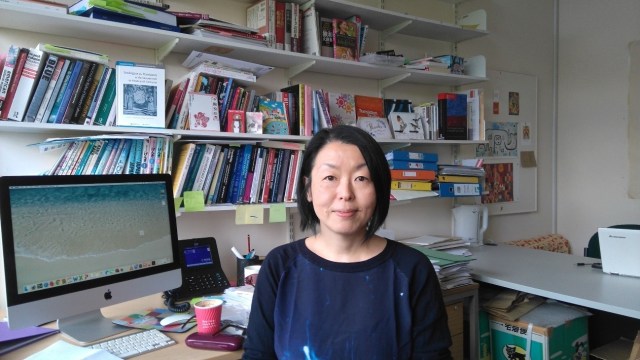
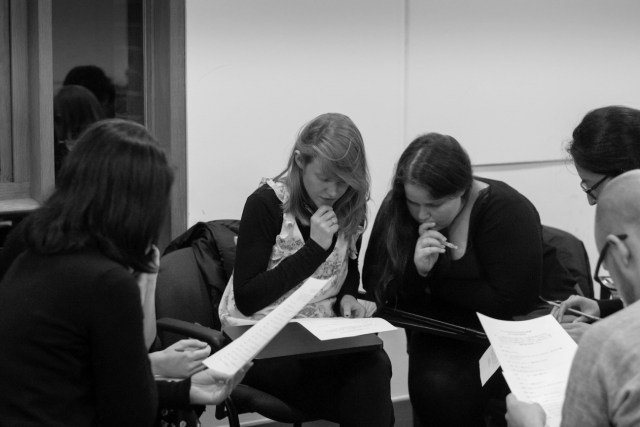
Camila França Photography
